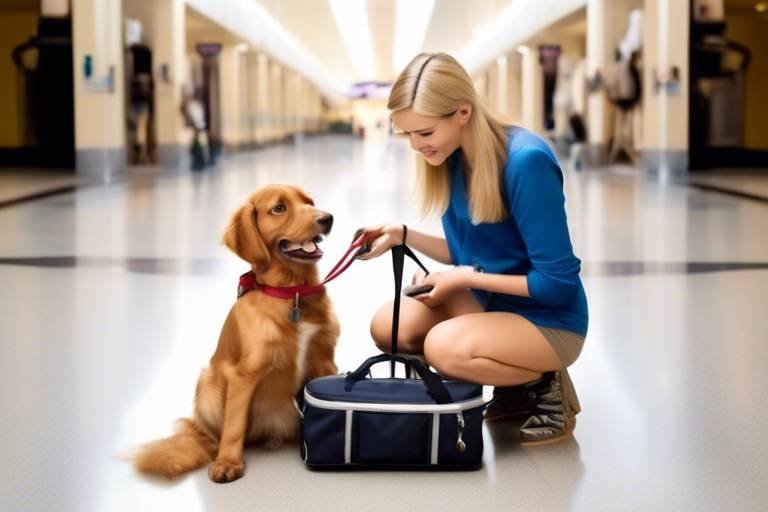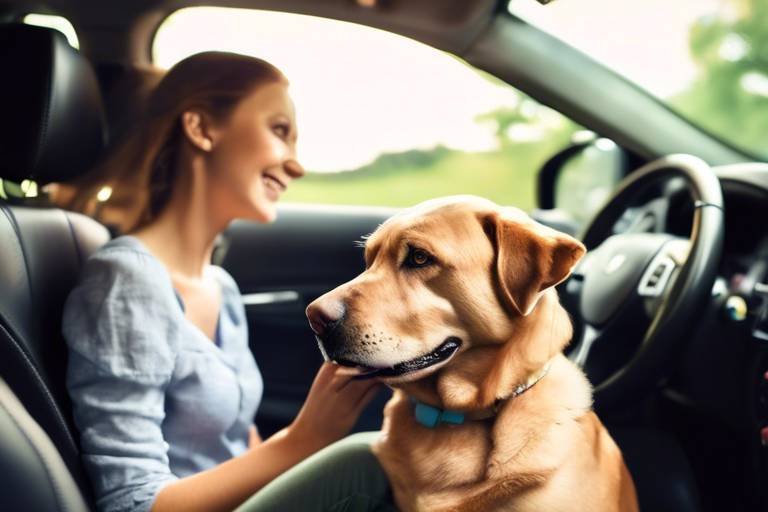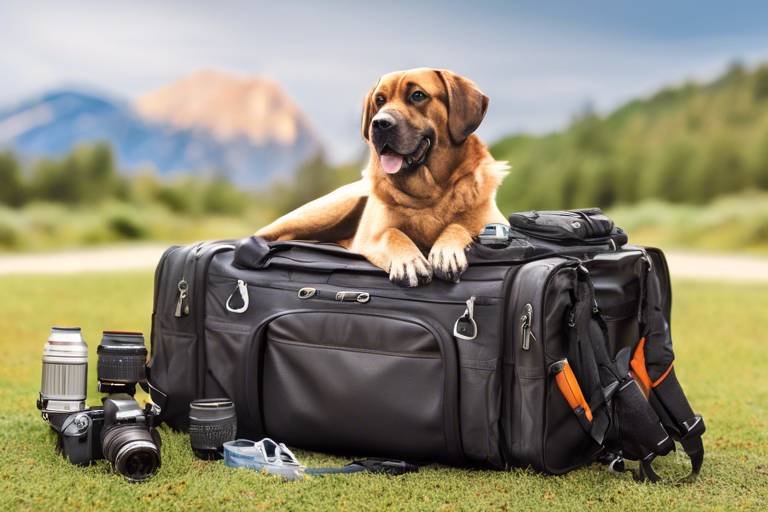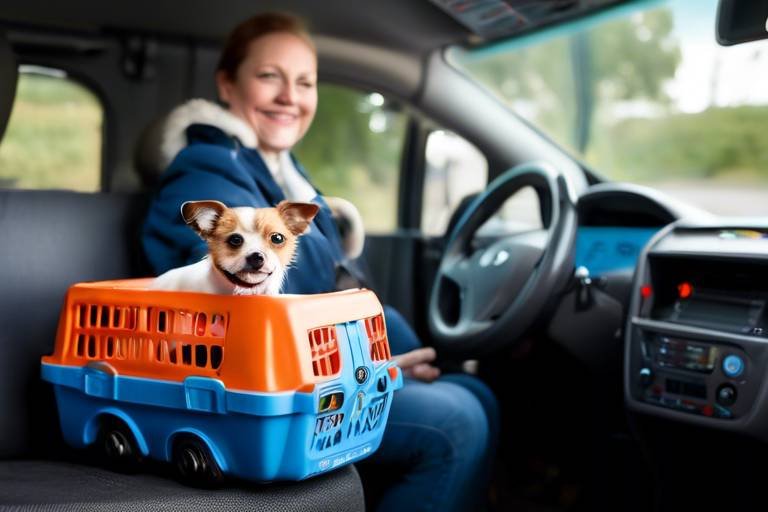Tips for Teaching Pets About New Places
Moving to a new place or even just visiting unfamiliar locations can be a daunting experience for our furry friends. Just like us, pets can feel anxious and uncertain when faced with new environments. This article provides effective strategies and insights for pet owners on how to help their furry friends adapt to new environments, ensuring a smooth transition and a positive experience for both pets and owners. By understanding your pet's behavior and employing gradual introductions, you can make the process less stressful and more enjoyable.
Recognizing how pets react to new surroundings is crucial. Each pet is unique, and their responses can vary widely. Some pets may be curious and eager to explore, while others may feel overwhelmed and seek to hide. Understanding these behavioral responses can help owners anticipate their pets' needs and emotions during the transition to unfamiliar places. For instance, a dog might wag its tail and sniff around excitedly, while a cat may crouch low and observe from a distance. Being aware of these behaviors allows you to tailor your approach to each individual pet.
Introducing pets to new environments gradually can ease anxiety. Instead of throwing them into the deep end, consider taking baby steps. Start by allowing your pet to explore a small area of the new environment before gradually expanding their territory. This not only helps them acclimate but also gives them a sense of control. For example, if you’re moving to a new home, let your pet explore one room at a time. This technique can significantly reduce their stress levels and help them feel more secure and comfortable throughout the process.
Establishing a designated safe area in new environments can help pets feel more at home. This space should be a cozy nook filled with familiar scents and comforting items. You can set up a pet bed, blankets, and toys in a quiet corner away from the hustle and bustle. This sanctuary allows pets to retreat when feeling overwhelmed, providing them with a sense of safety. Remember, a calm pet is a happy pet, and creating this safe space can make all the difference.
Bringing familiar items from home can significantly reduce stress for pets. Items such as their favorite toys, blankets, or even a piece of your clothing can provide comfort and reassurance in new surroundings. The scent of these items can create a sense of familiarity, making the new place feel a little more like home. It’s amazing how something as simple as a favorite toy can help ease anxiety and encourage exploration.
Using treats and praise can encourage pets to explore new places confidently. When your pet exhibits brave behavior, such as sniffing around or engaging with new people, reward them with a treat or verbal praise. This positive reinforcement helps pets associate new environments with rewarding experiences. Over time, they will learn that exploring new places can lead to fun and treats, making them more eager to embrace change.
Exposing pets to new people and animals in safe settings can enhance their adaptability. Socialization is key to helping pets adjust to new environments. Arrange playdates with other friendly pets or invite friends over who are comfortable around animals. This not only helps your pet get used to new faces but also builds their confidence in unfamiliar situations. Just remember to supervise interactions and ensure that your pet feels safe and secure at all times.
Tracking your pet's comfort level during transitions is essential. As they explore new environments, pay attention to their behavior. Are they becoming more relaxed, or do they seem increasingly anxious? Observing these behavioral changes can provide valuable insights. Recognizing signs of stress or happiness as pets adjust to new places will help you make informed decisions about how to proceed. It’s a journey, and being attuned to your pet's feelings is crucial for a successful transition.
Identifying signs of stress in pets can help owners intervene appropriately. Common stress indicators include excessive barking, hiding, panting, or refusal to eat. If you notice any of these signs, it’s important to take a step back and give your pet some space. Additionally, consider using calming aids such as pheromone diffusers or anxiety wraps to help alleviate their discomfort. Remember, patience is key; rushing the process can increase anxiety.
Recognizing and celebrating small achievements can boost your pet's confidence. Whether it’s exploring a new room or meeting a new friend, each step forward is worth celebrating. A simple treat or a happy dance can reinforce their progress and encourage them to keep going. This positive reinforcement not only strengthens your bond but also makes the journey of adaptation enjoyable for both you and your pet.
- How long does it take for a pet to adjust to a new environment?
Every pet is different, but typically, it can take anywhere from a few days to a few weeks for pets to adjust to a new place. - What should I do if my pet shows signs of severe anxiety?
If your pet is showing severe signs of anxiety, consult your veterinarian. They may recommend behavioral therapy or medication to help your pet cope. - Can I use my pet's favorite toys to help them adjust?
Absolutely! Familiar toys can provide comfort and reassurance, making the new environment feel more like home.

Understanding Your Pet's Behavior
This article provides effective strategies and insights for pet owners on how to help their furry friends adapt to new environments, ensuring a smooth transition and a positive experience for both pets and owners.
When it comes to introducing your pet to a new environment, understanding their behavior is key. Pets, much like us, have their own unique personalities and quirks that dictate how they react to change. Some pets might be curious and eager to explore, while others may exhibit signs of anxiety or fear. Recognizing these behaviors can help you tailor your approach to make the transition smoother.
For instance, many pets will display body language that can indicate how they feel in a new setting. A wagging tail might suggest excitement, while ears pinned back could signal fear. It's essential to pay attention to these cues. If your pet seems hesitant or scared, it’s crucial to take a step back and give them the space they need.
Some common behavioral responses to new places include:
- Exploration: Many pets will sniff around and investigate their surroundings, which is a natural instinct.
- Hiding: If your pet retreats to a corner or under furniture, they might be feeling overwhelmed.
- Vocalization: Increased barking or meowing can indicate stress or discomfort.
Understanding these behaviors can help you anticipate your pet's needs. For example, if your dog is barking excessively, it might be a sign that they need reassurance or a break from the stimulation of the new environment. On the other hand, if your cat is hiding, it may be beneficial to create a cozy space for them to retreat to until they feel more comfortable.
Another important factor to consider is the history your pet has with new experiences. If they have had negative encounters in the past, they may be more cautious in unfamiliar settings. Conversely, a pet that has been socialized well and exposed to various environments may adapt more quickly. This history shapes their behavior and reactions, and being mindful of this can help you better support them during the transition.
In summary, understanding your pet's behavior is not just about observing their actions; it’s about interpreting their feelings and emotions as they navigate a new environment. By being attuned to their needs and recognizing their signals, you can help them feel safe and secure, paving the way for a smoother adjustment.
Introducing pets to new environments gradually can ease anxiety. In this section, we discuss techniques for slowly acclimating pets to new spaces, ensuring they feel secure and comfortable throughout the process.
Establishing a designated safe area in new environments can help pets feel more at home. Here, we outline how to set up a comforting space that allows pets to retreat when feeling overwhelmed.
Bringing familiar items from home can significantly reduce stress for pets. This subsection discusses which items to include and how they can provide comfort and reassurance in new surroundings.
Using treats and praise can encourage pets to explore new places confidently. We delve into effective positive reinforcement techniques to help pets associate new environments with rewarding experiences.
Exposing pets to new people and animals in safe settings can enhance their adaptability. This section highlights the importance of socialization and offers tips for introducing pets to new friends.
Tracking your pet's comfort level during transitions is essential. This section covers how to observe behavioral changes and recognize signs of stress or happiness as pets adjust to new places.
Identifying signs of stress in pets can help owners intervene appropriately. We outline common stress indicators and suggest strategies for alleviating anxiety during the adjustment period.
Recognizing and celebrating small achievements can boost your pet's confidence. This subsection emphasizes the importance of acknowledging progress as pets become more comfortable in their new environments.
Here are some common questions pet owners have when transitioning their pets to new places:
- How long does it take for a pet to adjust to a new environment? It varies by pet but can take anywhere from a few days to several weeks.
- What should I do if my pet shows signs of stress? Create a safe space, use calming techniques, and consult a vet if necessary.
- Can I help my pet adjust faster? Yes! Gradual introductions and positive reinforcement can significantly help.

Gradual Introductions
Introducing your pet to a new environment can be a daunting experience, not just for them but for you as well. Imagine stepping into a bustling city for the first time; the sounds, the sights, and the sheer number of people can be overwhelming. Your furry friend feels the same way! To ease their anxiety, it’s essential to take a gradual approach. This means slowly introducing them to the new space, allowing them to explore at their own pace. Start with short visits to the new location, gradually increasing the duration as they become more comfortable. Just like a child learning to swim, you wouldn’t throw them into the deep end right away, right? Instead, you’d let them wade in slowly, getting used to the water.
One effective technique is to allow your pet to explore one room at a time. This can prevent them from feeling overwhelmed by the entire space all at once. For instance, if you’ve just moved into a new house, begin by letting them explore the living room while you’re there to supervise. Once they seem relaxed, you can introduce them to the next room. This method not only helps them feel secure but also builds their confidence as they discover new areas.
Another strategy is to incorporate familiar scents into the new environment. Pets are highly sensitive to smells, and bringing items that smell like home can provide a sense of comfort. You can place their favorite blanket or a piece of your clothing in the new space. This simple act can make a world of difference, transforming an unfamiliar place into a more welcoming environment.
Moreover, consider scheduling visits during quieter times. If you’re introducing your pet to a public space, such as a park or a pet-friendly café, try going during off-peak hours. Fewer people and less noise can significantly reduce your pet’s anxiety. As they become more accustomed to the environment, you can gradually increase their exposure to busier times.
Lastly, be patient and observant. Every pet is unique, and their comfort levels will vary. Watch for signs of stress or excitement, and adjust your approach accordingly. If your pet seems anxious, take a step back and give them more time to acclimate. Remember, it’s all about making the experience positive for them. With gradual introductions, you’re setting the stage for a smooth transition, ensuring that both you and your furry friend can enjoy your new adventures together!
Creating a Safe Space
When introducing your pet to a new environment, one of the most important steps is to create a safe space for them. This is a designated area where your furry friend can retreat to feel secure and relaxed amidst the chaos of unfamiliar surroundings. Think of it as their personal sanctuary—a cozy corner that feels like home, even when everything else is new and potentially overwhelming. It’s essential to set this up before you even bring your pet into the space. By doing so, you provide a sense of stability and comfort that can make all the difference in their adjustment process.
To create an ideal safe space, consider the following elements:
- Location: Choose a quiet corner of the new environment, away from high traffic areas, loud noises, or bright lights. This could be a separate room or a cozy nook where your pet can feel undisturbed.
- Comfortable Bedding: Provide a soft bed or blanket that carries their scent from home. This familiarity can soothe their nerves and help them feel more at ease.
- Toys and Chews: Include some of their favorite toys or chew items. Engaging with familiar toys can help distract them from any anxiety they may be feeling.
- Food and Water: Make sure to place their food and water bowls nearby. Keeping their essentials within reach will help them settle in without having to venture too far.
Once you have established this safe space, allow your pet to explore it at their own pace. Don’t force them to stay there, but encourage them to use it whenever they need a break. You might find that they gravitate towards this area when feeling stressed or overwhelmed, and that’s perfectly normal. It’s their way of telling you they need a moment to recharge.
Moreover, it’s crucial to maintain a calm atmosphere around this safe space. If your pet feels the energy in the room is tense or chaotic, they are less likely to use their designated area. So, keep the volume down, avoid sudden movements, and speak softly around them. This will help reinforce the idea that their safe space is a peaceful retreat.
Lastly, remember to gradually introduce your pet to other areas of the new environment. Once they seem comfortable in their safe space, you can start to encourage them to explore the rest of the house or yard, always returning to their sanctuary when they need to feel secure. This gradual exposure will help them build confidence and adapt more quickly to their new surroundings.
Q: How long should I expect my pet to stay in their safe space?
A: It varies by pet. Some may feel secure in a few hours, while others might take days or even weeks. Be patient and allow them to dictate their comfort level.
Q: Can I use a crate as a safe space?
A: Yes! A crate can be an excellent safe space if your pet is crate-trained. Just ensure it’s comfortable and filled with familiar items.
Q: What if my pet refuses to use the safe space?
A: If your pet isn’t using their safe space, try adding more familiar items or adjusting the location. Sometimes, a slight change can make a big difference.
Familiar Items
When it comes to helping our furry friends adapt to new environments, one of the most effective strategies is to surround them with . Think of it this way: just as we might feel more at ease in a new place if we have a favorite blanket or a cherished photo, pets also find comfort in their belongings. Bringing along their favorite toys, bedding, or even a piece of your clothing can provide a sense of security that eases their transition.
Familiar items serve as anchors in a sea of new experiences. For instance, a dog may feel anxious in a new home, but having their favorite chew toy nearby can transform that anxiety into curiosity and playfulness. Similarly, cats often seek out their designated spots, and having their familiar bed can encourage them to explore their new surroundings at their own pace.
Here are some essential items you might consider bringing:
- Favorite Toys: These can provide comfort and a sense of normalcy. A beloved squeaky toy or a soft stuffed animal can make all the difference.
- Bedding: Familiar scents can be incredibly calming. Bringing their bed or a blanket can create a cozy nook where they feel safe.
- Food and Water Bowls: Using their own bowls can help maintain a routine and make mealtime feel familiar, even in a new place.
- Clothing or Accessories: Items like a favorite collar or a piece of your clothing can carry familiar scents that soothe your pet.
It's important to remember that while these items can significantly reduce stress, the key is to introduce them in a way that feels natural and unforced. Allow your pet to explore their new environment while having access to these familiar items. This approach not only helps alleviate anxiety but also promotes a sense of ownership in their new space.
In essence, familiar items act as a bridge between the old and the new, allowing pets to navigate their new surroundings with confidence. So, next time you’re moving or visiting a new place, don’t forget to pack those precious items that make your pet feel at home. After all, a happy pet means a happy owner!
Positive Reinforcement
When it comes to helping our furry friends feel at ease in new environments, is a game changer. Think of it as the secret sauce that transforms a daunting situation into an exciting adventure for your pet. Instead of just telling your pet, "It's okay," why not show them through actions that make them feel good? Using treats and praise effectively can create a powerful association between new places and rewarding experiences.
Imagine your pet stepping into a new park for the first time. Instead of letting them wander off into uncertainty, you can be right there, showering them with treats and enthusiastic praise whenever they explore or interact positively with their surroundings. This immediate feedback not only boosts their confidence but also encourages them to embrace the newness of their environment. It's like giving them a little cheerleading squad, right in their pocket!
To maximize the benefits of positive reinforcement, consider the following strategies:
- Timing is Everything: Offer treats and praise immediately after your pet exhibits the desired behavior. This helps them make the connection between their actions and the reward.
- Use High-Value Treats: In new environments, your pet might need a little extra motivation. Opt for their favorite treats—something they can’t resist!
- Keep it Short and Sweet: Don’t overwhelm your pet with too much at once. Short, positive sessions will help them build confidence without feeling stressed.
Moreover, remember that every pet is unique. What works for one might not work for another. Some pets may respond better to verbal praise, while others might be more treat-driven. It's about finding that sweet spot that resonates with your furry friend.
In conclusion, positive reinforcement is not just about rewards; it's about building a bond of trust and understanding with your pet. By creating an environment where they feel safe and appreciated, you're not only helping them adapt to new places but also enriching your relationship with them. So, the next time you venture into unfamiliar territory, pack those treats and your most encouraging words—your pet will thank you for it!
Q1: How long should I use positive reinforcement when introducing my pet to new places?
A1: It's best to use positive reinforcement consistently during the initial introductions. As your pet becomes more comfortable, you can gradually reduce the frequency of treats while still offering praise.
Q2: What if my pet doesn't respond to treats?
A2: Every pet is different. If treats aren’t motivating, try using their favorite toy or engaging in a fun activity as a reward. The key is to find what excites them!
Q3: Can positive reinforcement help with other behavioral issues?
A3: Absolutely! Positive reinforcement can be effective in addressing various behavioral issues, from anxiety to training commands. It encourages good behavior in a supportive way.
Q4: How can I tell if my pet is stressed in a new environment?
A4: Look for signs such as excessive panting, hiding, or refusal to engage. If you notice these behaviors, it may be a good idea to take a step back and allow your pet to acclimate at their own pace.
Socialization Opportunities
One of the most enriching experiences for your pet is the opportunity for socialization. Just like us, pets thrive on interactions with others, whether they be humans or fellow furry friends. Socialization not only helps them adapt to new environments but also fosters their overall well-being. Think of it as a social gym where your pet can build confidence and learn essential life skills. But how do you create these opportunities? Let’s dive into some effective strategies!
First, consider starting small. You don’t want to overwhelm your pet with a crowd of strangers right off the bat. Instead, look for controlled environments where your pet can meet new people and animals at a comfortable pace. For instance, visiting a local dog park during off-peak hours can provide a less chaotic atmosphere for your pet to explore. This way, they can gradually get accustomed to the sights, sounds, and smells of a bustling environment without feeling cornered or stressed.
Another great way to promote socialization is through training classes. These classes not only teach your pet obedience but also expose them to other pets and people in a structured setting. Think of it as a classroom where your pet can learn the ropes of social interaction. Plus, it’s an excellent opportunity for you to connect with other pet owners, share experiences, and even make new friends!
When introducing your pet to new friends, be sure to monitor their body language closely. Signs of excitement, such as wagging tails and playful barks, are great indicators that your pet is enjoying the experience. However, if you notice signs of stress—like excessive panting, tucked tails, or growling—it's crucial to step back and give your pet some space. Remember, every pet is unique, and their comfort levels will vary.
Additionally, consider setting up playdates with other pets that have a calm demeanor. This can be a fantastic way for your pet to learn proper social cues and behaviors. You might find that your pet enjoys the company of another dog or cat, leading to a wonderful friendship that enriches both of their lives.
Lastly, don’t forget about the power of positive reinforcement. Whenever your pet successfully interacts with another animal or person, shower them with praise or a treat. This creates a positive association with socialization, encouraging them to be more open and confident in future encounters. Just like we feel good when we receive compliments, your pet will thrive on that positive feedback!
In conclusion, socialization opportunities are not just beneficial for your pet; they are essential. By providing a variety of experiences and monitoring their reactions, you can help your furry friend become a well-adjusted and happy companion. Remember, it’s all about taking it one paw at a time!
- How can I tell if my pet is stressed during socialization?
Look for signs such as excessive panting, hiding, or refusal to engage. If you notice these behaviors, it may be best to remove them from the situation and try again later.
- What age should I start socializing my pet?
It's best to start socialization as early as possible, ideally during the puppy or kitten stages. However, older pets can still benefit from gradual socialization.
- How often should I socialize my pet?
Regular interactions are ideal. Aim for a few socialization opportunities each week to help your pet feel comfortable and confident.

Monitoring Your Pet's Progress
When it comes to helping your furry friend adapt to new environments, monitoring their progress is just as important as the initial introduction. It’s like being a detective in your pet’s life, observing their behaviors and emotions as they navigate through this new chapter. Are they excited, anxious, or indifferent? Each reaction tells a story, and it’s our job to listen. By keeping an eye on how your pet adjusts, you can ensure they are on the right path to feeling at home.
One of the first steps in monitoring your pet's progress is to establish a baseline of their behavior before the move. Pay attention to their typical reactions in familiar settings. This way, you’ll have a reference point to compare against once they’re exposed to the new environment. For instance, if your dog usually greets new people with a wagging tail and happy barks, but suddenly becomes timid and hides, that’s a clear sign they’re experiencing stress. Similarly, if your cat, who typically loves to explore, suddenly refuses to leave their safe space, it’s time to take a closer look at their emotional state.
As you observe your pet, look for behavioral changes that might indicate how they’re feeling. Here are some signs of stress to watch out for:
- Excessive barking or meowing
- Hiding or seeking isolation
- Loss of appetite
- Destructive behavior
- Excessive grooming
If you notice any of these signs, it’s essential to take action. Consider providing your pet with extra comfort items, engaging in more playtime, or even consulting a veterinarian for advice on how to ease their anxiety. Remember, it’s perfectly normal for pets to take time to adjust, and being patient can go a long way in helping them feel secure.
On the flip side, it’s equally important to recognize the signs of happiness and comfort in your pet. Look for behaviors like:
- Curiosity about their surroundings
- Engaging in play
- Exploring new spaces with confidence
- Seeking out interaction with you
- Relaxed body language, such as a wagging tail or purring
Celebrating these small victories can be incredibly rewarding for both you and your pet. Each time you notice your furry friend becoming more comfortable, take a moment to acknowledge it. Perhaps treat them to their favorite snack or play their favorite game. This not only reinforces their positive experiences but also strengthens the bond between you two.
In summary, monitoring your pet's progress in a new environment is a continuous journey that requires observation, patience, and a lot of love. By being attentive to their needs and emotions, you can help them transition smoothly and create a happy, healthy living situation for both of you. Remember, every pet is unique, and understanding their individual responses will pave the way for a successful adaptation.
Q: How long does it typically take for a pet to adjust to a new environment?
A: The adjustment period can vary widely depending on the pet’s personality and past experiences. Some pets may adapt within a few days, while others may take weeks or even months. It's essential to be patient and supportive throughout this process.
Q: What should I do if my pet shows signs of stress?
A: If your pet shows signs of stress, try to create a safe and comforting space for them. Use familiar items, engage in calming activities, and consider consulting with a veterinarian for further advice.
Q: Can I help my pet adjust faster?
A: Yes! Gradual introductions, positive reinforcement, and regular socialization can significantly aid in your pet's adaptation to new places. Always ensure that the experiences are positive to help build their confidence.
Signs of Stress
Understanding the in your pet is crucial for ensuring their well-being, especially when they are adjusting to new environments. Just like humans, pets can experience anxiety and discomfort, and it's our job as responsible pet owners to recognize these signals. Stress in pets can manifest in various ways, and being able to identify these signs can help you intervene and provide the necessary support.
Common indicators of stress include behaviors such as excessive barking, hiding, or even destructive tendencies. For instance, if your dog suddenly starts chewing on furniture or digging at the carpet, it may be a sign that they are feeling overwhelmed. Similarly, if your cat begins to hide under the bed or in a closet, this could indicate that they are not comfortable in their new surroundings.
Here are some specific signs to watch for:
- Increased vocalization: If your pet is barking, meowing, or whining more than usual, it could be their way of expressing discomfort.
- Changes in appetite: A stressed pet may refuse to eat or drink, or they may overeat as a coping mechanism.
- Excessive grooming: Cats, in particular, may groom themselves excessively when they are anxious, leading to bald patches or skin irritations.
- Body language: Look for signs such as a tucked tail, flattened ears, or wide eyes, which can indicate fear or anxiety.
It's essential to monitor your pet's behavior closely during this transition period. If you notice any of these signs, it may be time to take a step back and assess the situation. Perhaps your pet needs a quiet space to retreat to, or maybe they require more time to adjust to their new environment. Remember, patience is key!
In addition to recognizing stress signals, it's also important to implement strategies that can help alleviate your pet's anxiety. Providing a safe space where they can feel secure, using familiar items from home, and employing positive reinforcement techniques can all contribute to a smoother transition. By being attentive to your pet's needs and responding appropriately, you can help them navigate their new surroundings with confidence and ease.
Q: How long does it usually take for pets to adjust to a new environment?
A: The adjustment period can vary widely depending on the individual pet's personality and past experiences. Some pets may adapt within a few days, while others might take weeks or even months.
Q: What should I do if I notice signs of stress in my pet?
A: If you observe signs of stress, try to create a calm environment for your pet. Offer them a safe space, engage in gentle play, or use calming products like pheromone diffusers. If the stress persists, consider consulting a veterinarian or a pet behaviorist.
Q: Can I help my pet feel more comfortable in a new place?
A: Yes! Gradual introductions to new spaces, bringing familiar items, and using positive reinforcement can all help your pet feel more at ease. Be patient and allow your pet to explore at their own pace.
Celebrating Small Victories
When it comes to helping our furry friends adjust to new environments, it's essential to remember that every little step counts. Just like us, pets can feel overwhelmed during transitions, and acknowledging their progress can make a world of difference. Celebrating small victories not only boosts their confidence but also strengthens the bond between you and your pet. Imagine your pet as a tiny explorer, bravely navigating through uncharted territories—every wag of the tail or curious sniff is a milestone worth celebrating!
So, how do we recognize and celebrate these small victories? It could be as simple as your dog taking a few steps into a new room or your cat exploring a new corner of the house. Each time they show curiosity or comfort in a new space, it's an opportunity for you to express your joy and encouragement. You might say something like, "Good job, buddy!" or offer a gentle pat on the back. These affirmations not only reassure your pet but also reinforce their positive behavior.
Additionally, consider incorporating treats into your celebration routine. A small reward can serve as a tangible acknowledgment of their bravery. For instance, if your dog successfully meets a new friend at the park, offer them a favorite treat as a reward. This positive reinforcement helps them associate new experiences with good feelings, paving the way for more adventurous explorations in the future.
Here’s a quick table to illustrate some examples of small victories you might celebrate:
| Small Victory | Celebration Idea |
|---|---|
| Exploring a new room | Verbal praise and a treat |
| Meeting a new person | Playtime with a favorite toy |
| Calm behavior in a crowded place | Extra cuddles and a special snack |
| Using a new litter box or bed | Offering a new toy as a reward |
Remember, the key is to be genuine in your celebrations. Your enthusiasm will not only uplift your pet but will also create a positive atmosphere that encourages them to keep exploring. Just like a child learning to ride a bike, your pet needs to know that it's okay to take risks and that every small victory is a step toward greater adventures. So, keep those treats handy and don’t hesitate to shower them with love and praise—your pet’s journey to confidence in new places is worth celebrating!
- How long does it take for pets to adjust to new places?
Every pet is unique, and adjustment periods can vary widely. Some pets may acclimate in a few days, while others may take weeks. Patience is key! - What should I do if my pet shows signs of stress?
If your pet appears anxious, provide a safe space and try to minimize exposure to overwhelming stimuli. Gradually introduce new environments and use positive reinforcement to encourage exploration. - Are certain breeds more adaptable than others?
Yes, some breeds are naturally more adaptable due to their temperament. However, individual personality plays a significant role in adaptability, so it's essential to assess each pet's unique traits. - Can I use toys to help my pet adjust?
Absolutely! Familiar toys can provide comfort and a sense of security. Introducing new toys can also make exploring more fun and engaging for your pet.
Frequently Asked Questions
- How can I help my pet adjust to a new environment?
Helping your pet adjust to a new environment involves a few key strategies. Start by introducing them to the new space gradually. Allow them to explore at their own pace, and create a safe space where they can retreat if they feel overwhelmed. Bringing familiar items from home can also provide comfort. Remember, patience is key!
- What signs indicate that my pet is stressed in a new place?
Common signs of stress in pets include excessive barking or meowing, hiding, pacing, or changes in eating and sleeping habits. If you notice your pet exhibiting any of these behaviors, it's important to intervene. Offer comfort, and consider spending more time with them in their safe space until they feel more secure.
- Can positive reinforcement help my pet adapt?
Absolutely! Positive reinforcement is a powerful tool in helping pets feel more comfortable in new environments. Use treats, praise, and playtime to encourage exploration and positive interactions. This not only builds confidence but also helps your pet associate the new place with enjoyable experiences.
- How can I create a safe space for my pet?
To create a safe space for your pet, choose a quiet area in your new home where they can feel secure. Set up their bed, toys, and any familiar items. This designated area will be a retreat for them when they need a break from the new surroundings. Make sure it's away from loud noises or high-traffic areas.
- What should I do if my pet shows signs of fear or anxiety?
If your pet shows signs of fear or anxiety, it's crucial to remain calm and supportive. Avoid forcing them into situations that make them uncomfortable. Instead, provide reassurance and allow them to acclimate at their own pace. Gradually expose them to new experiences while using positive reinforcement to encourage bravery.
- How long does it typically take for a pet to adjust to a new home?
The adjustment period can vary greatly depending on the individual pet's personality and past experiences. Some pets may adapt within a few days, while others might take several weeks. Be patient and attentive to their needs, and celebrate small victories along the way to help boost their confidence.
- Is socialization important for my pet in a new environment?
Yes! Socialization is crucial for helping pets adapt to new environments. Introducing them to new people and friendly animals in a controlled manner can enhance their confidence and reduce anxiety. Just ensure that these interactions are positive and safe to create a welcoming experience for your furry friend.



















